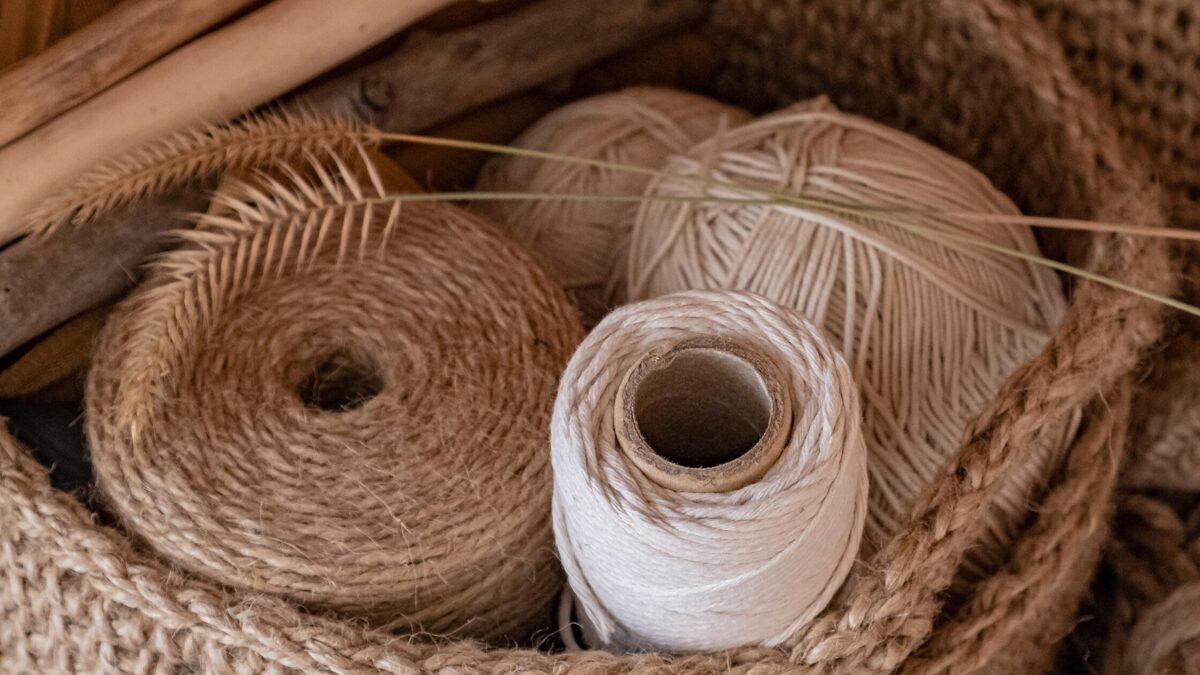Hemp vs. Cotton: A Comparison of Eco-Friendly Fibers
November 10, 2024 at 5:00 am,
No comments

In the search for sustainable textiles, hemp and cotton often come up as two of the most popular natural fibers. While both are widely used in clothing and other fabric-based products, they differ greatly in terms of their environmental impact. As the world looks for greener alternatives in the fashion industry, it’s important to understand how these two fibers compare. From water usage and pesticide needs to overall sustainability, let’s explore why hemp could be the future of eco-friendly fabrics.
Water Usage: A Clear Winner
When it comes to water consumption, hemp far outshines cotton. Cotton is notoriously thirsty, with each kilogram requiring an average of 10,000 liters of water to grow. This heavy water demand has serious consequences, particularly in regions where water is already scarce. In comparison, hemp requires only about 2,700 liters of water per kilogram—almost one-quarter of what cotton needs. Hemp can also thrive with minimal irrigation, often relying solely on rainwater, making it a much more water-efficient choice.
The implications of this difference in water usage are significant. With growing concerns about water conservation, choosing hemp over cotton can help reduce the environmental strain caused by textile production. This is especially relevant in areas where water resources are under pressure, as opting for hemp could alleviate some of that burden.
Pesticide and Herbicide Needs: Hemp’s Natural Resilience
Cotton is one of the most pesticide-intensive crops in the world. It accounts for around 16% of global insecticide use and 7% of all herbicides, even though it occupies only about 2.5% of the world’s agricultural land. This heavy pesticide use can have negative effects on the environment, from contaminating water sources to harming local ecosystems. Pesticide residues can also remain in the fabric, potentially impacting consumers and garment workers alike.
Hemp, on the other hand, is naturally resistant to pests and diseases, reducing the need for chemical intervention. In many cases, it can be grown with little to no pesticides or herbicides, which is not only better for the environment but also promotes a healthier work environment for farmers. By choosing hemp, the textile industry can reduce its reliance on harmful chemicals, supporting cleaner air, soil, and water.
Environmental Impact and Soil Health: Hemp as a Soil Savior
Cotton farming often leads to soil depletion and degradation due to intensive farming practices and chemical use. Over time, this can result in diminished soil quality, making it harder to grow future crops and reducing agricultural sustainability. Conversely, hemp offers several benefits for soil health. Its deep root system helps prevent soil erosion and improves soil structure by aerating and breaking up compacted ground.
Additionally, hemp is known for its ability to remediate contaminated soil through a process known as phytoremediation. This means it can absorb toxins and heavy metals from the ground, restoring soil health and making it more fertile for future planting. Because of this, hemp not only has a lower environmental impact than cotton but also actively contributes to soil regeneration, which is essential for long-term sustainability in agriculture.
Carbon Footprint: A Greener Choice
Hemp is highly efficient at absorbing carbon dioxide, making it an excellent crop for carbon sequestration. It can absorb more CO₂ per hectare than many other crops, helping to offset greenhouse gas emissions. Cotton, while still a natural fiber, does not have the same carbon-sequestering capabilities as hemp. In a time when reducing carbon footprints is crucial, hemp stands out as a greener choice for the textile industry.
Durability and Lifespan: Reducing Waste Through Longevity
Hemp fibers are incredibly strong and durable, which means products made from hemp tend to last longer than those made from cotton. Hemp clothing, for instance, is known for being highly resistant to wear and tear, making it a wise investment for consumers looking to reduce waste. The longer a product lasts, the less frequently it needs to be replaced, which helps to reduce the overall consumption of resources.
Cotton, although soft and breathable, tends to wear out more quickly, particularly when subjected to frequent washing. Choosing hemp over cotton can therefore lead to more sustainable consumption patterns, as longer-lasting items translate to less waste and a reduced demand for new resources.
Water Usage: A Clear Winner
When it comes to water consumption, hemp far outshines cotton. Cotton is notoriously thirsty, with each kilogram requiring an average of 10,000 liters of water to grow. This heavy water demand has serious consequences, particularly in regions where water is already scarce. In comparison, hemp requires only about 2,700 liters of water per kilogram—almost one-quarter of what cotton needs. Hemp can also thrive with minimal irrigation, often relying solely on rainwater, making it a much more water-efficient choice.
The implications of this difference in water usage are significant. With growing concerns about water conservation, choosing hemp over cotton can help reduce the environmental strain caused by textile production. This is especially relevant in areas where water resources are under pressure, as opting for hemp could alleviate some of that burden.
Pesticide and Herbicide Needs: Hemp’s Natural Resilience
Cotton is one of the most pesticide-intensive crops in the world. It accounts for around 16% of global insecticide use and 7% of all herbicides, even though it occupies only about 2.5% of the world’s agricultural land. This heavy pesticide use can have negative effects on the environment, from contaminating water sources to harming local ecosystems. Pesticide residues can also remain in the fabric, potentially impacting consumers and garment workers alike.
Hemp, on the other hand, is naturally resistant to pests and diseases, reducing the need for chemical intervention. In many cases, it can be grown with little to no pesticides or herbicides, which is not only better for the environment but also promotes a healthier work environment for farmers. By choosing hemp, the textile industry can reduce its reliance on harmful chemicals, supporting cleaner air, soil, and water.
Environmental Impact and Soil Health: Hemp as a Soil Savior
Cotton farming often leads to soil depletion and degradation due to intensive farming practices and chemical use. Over time, this can result in diminished soil quality, making it harder to grow future crops and reducing agricultural sustainability. Conversely, hemp offers several benefits for soil health. Its deep root system helps prevent soil erosion and improves soil structure by aerating and breaking up compacted ground.
Additionally, hemp is known for its ability to remediate contaminated soil through a process known as phytoremediation. This means it can absorb toxins and heavy metals from the ground, restoring soil health and making it more fertile for future planting. Because of this, hemp not only has a lower environmental impact than cotton but also actively contributes to soil regeneration, which is essential for long-term sustainability in agriculture.
Carbon Footprint: A Greener Choice
Hemp is highly efficient at absorbing carbon dioxide, making it an excellent crop for carbon sequestration. It can absorb more CO₂ per hectare than many other crops, helping to offset greenhouse gas emissions. Cotton, while still a natural fiber, does not have the same carbon-sequestering capabilities as hemp. In a time when reducing carbon footprints is crucial, hemp stands out as a greener choice for the textile industry.
Durability and Lifespan: Reducing Waste Through Longevity
Hemp fibers are incredibly strong and durable, which means products made from hemp tend to last longer than those made from cotton. Hemp clothing, for instance, is known for being highly resistant to wear and tear, making it a wise investment for consumers looking to reduce waste. The longer a product lasts, the less frequently it needs to be replaced, which helps to reduce the overall consumption of resources.
Cotton, although soft and breathable, tends to wear out more quickly, particularly when subjected to frequent washing. Choosing hemp over cotton can therefore lead to more sustainable consumption patterns, as longer-lasting items translate to less waste and a reduced demand for new resources.
Why Hemp Could Be the Future of Sustainable Fabrics
As concerns about the environmental impact of the fashion industry grow, hemp presents itself as a compelling alternative to conventional cotton. With its low water requirements, minimal pesticide needs, and positive effects on soil health, hemp has the potential to revolutionize the textile industry. Its durability and carbon-sequestering abilities further bolster its reputation as a sustainable choice.
While cotton has long been the go-to fiber for many, the drawbacks associated with its cultivation and environmental impact cannot be overlooked. Hemp offers a viable solution, not just as an eco-friendly alternative but as a crop that actively supports environmental restoration. As the demand for sustainable fabrics increases, embracing hemp could help pave the way for a more responsible and eco-conscious fashion industry.
In the end, choosing hemp over cotton is not only a step towards reducing the ecological footprint of textiles but also an investment in a more sustainable and resilient future. The next time you’re shopping for clothes, consider the environmental impact of your choices and how hemp can make a positive difference.
As concerns about the environmental impact of the fashion industry grow, hemp presents itself as a compelling alternative to conventional cotton. With its low water requirements, minimal pesticide needs, and positive effects on soil health, hemp has the potential to revolutionize the textile industry. Its durability and carbon-sequestering abilities further bolster its reputation as a sustainable choice.
While cotton has long been the go-to fiber for many, the drawbacks associated with its cultivation and environmental impact cannot be overlooked. Hemp offers a viable solution, not just as an eco-friendly alternative but as a crop that actively supports environmental restoration. As the demand for sustainable fabrics increases, embracing hemp could help pave the way for a more responsible and eco-conscious fashion industry.
In the end, choosing hemp over cotton is not only a step towards reducing the ecological footprint of textiles but also an investment in a more sustainable and resilient future. The next time you’re shopping for clothes, consider the environmental impact of your choices and how hemp can make a positive difference.
